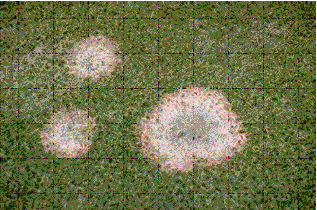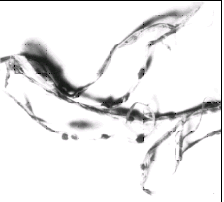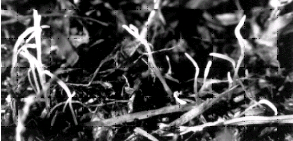| Snow molds are cold tolerant fungi that grow at freezing
or near freezing temperatures. Snow molds can damage turfgrasses from
late fall to spring and at snow melt or during cold, drizzly periods
when snow is absent. It causes roots, stems, and leaves to rot when
temperatures range from 25 to 60 F (-3 to 15 C). When the grass surface
dries out and the weather warms, snow mold fungi cease to attack;
however, infection can reappear in the area year after year.
Snow molds are favored by excessive early fall applications of
fast release nitrogenous fertilizers, excessive shade, a thatch
greater than 3/4 inch thick, or mulches of straw, leaves, synthetics,
and other moisture-holding debris on the turf. Disease is most serious
when air movement and soil drainage are poor and the grass stays
wet for long periods, e.g., where snow is deposited in drifts or
piles.
All turfgrasses grown in the Midwest are susceptible to one or
more snow mold fungi. They include Kentucky and annual bluegrasses,
fescues, bentgrasses, ryegrasses, bermudagrass, and zoysiagrasses
with bentgrasses often more severely damaged than coarser turfgrasses.
There are two types of snow mold in the Midwest: gray or speckled
snow mold, also known as Typhula blight or snow scald, and pink
snow mold or Fusarium patch. The two types are found in the same
geographical areas in the Midwest, including Illinois. Pink snow
mold occurs farther south than gray snow mold.
Back to Top |

Figure
1.
Gray snow mold on a home lawn (courtesy R. Alden Miller).

Figure
2.
Pink snow mold or Fusarium patch. {atches are 8-12 inches across,
covered with pink mold as snow melts (courtesy R.W. Smiley).
|
|

Figure
3.
Sclerotia of the gray snow mold fungus (Typhula) embedded in grass
leaves (courtesy Dr. R.E. Partyka).
|
GRAY SNOW MOLD OR TYPHULA BLIGHT
Gray or speckled snow mold is caused by the fungus Typhula incarnata
and three varieties of typhula ishikariensis. A deep and
prolonged snow cover on unfrozen soil, tall grass matted down, and
unbalanced nitrogen fertilization produces favorable conditions
for disease development. The fungus (or fungi) are less active while
the turf and soil are frozen. In early spring, when the snow melts
and the turf thaws, the fungus may again become active, and diseased
patches may enlarge. As the weather warms and the turf dries, Typhula
becomes dormant until mid to late autumn. The optimum temperature
for infection is between 30 and 45 F (-1 to 7 C). All northern turfgrasses
are susceptible, with bentgrasses and annual bluegrass being most
susceptible. Kentucky bluegrass cultivars differ in resistance to
the Typhula fungi. The fine leaved fescues are commonly more
resistant than are Kentucky bluegrasses and especially bentgrasses.
|
Symptoms
After snow melt, gray snow mold appears as roughly circular, white
to grayish white areas with regular margins that coalesce to form
areas up to 2 or 3 feet in diameter (Figure 1). The disease is active
where the snow is melting. Several spots may merge, forming large,
irregular, straw-colored dead areas. The wet grass may be matted
together and covered at first with a fluffy, grayish white mold
(mycelium) that is speckled with numerous pale to dark brown or
black sclerotia (Figure 3). The mold soon turns bluish gray to almost
black. At other times a silvery membraneous crust develops over
the injured turf. When conditions favor disease development, large
turf areas may be killed but commonly, only the leaves are killed
and new leaves form from the over wintered plant crowns. Old gray
mold "scars" may be evident until May or early June (Figure
4).
|

Figure
4.
Sporocaps of typhula incarnata, a common gray snow mold fungus
(courtesy Noel Jackson).
|
Disease Cycle
After the period of active mycelial growth when the snow melts, the Typhula
fungi produce small (0.2 to 5 mm), roundish or flattened, orange yellow
to tan or reddish brown, chocolate brown, or black survival structures
called sclerotia. (The sclerotia of T. ishikariensis are tiny and
black when mature). The hard sclerotia are embedded in or attached to
the leaves and crowns of diseased plants (Figure 3) and lie dormant during
the following summer and early autumn. The sclerotia germinate in cold,
wet weather or after autumn snow melt to produce delicate, pink to grayish
white, spore bearing sporocarps up to 20 mm tall or hyphae with clamp
connections that infect all tissues of the grass plant and start the disease.
Cultivars of Kentucky bluegrass resistant to one or more Typhula
fungi include Adelphi, Baron, Bonnieblue, Galaxie, Glade, and Monopoly.
Very susceptible Kentucky bluegrasses include Fylking, Merion, Nugget,
Pennstar, and South Dakota Common or Certified. The red fescues are, in
general, more resistant to gray snow mold than are Kentucky bluegrass
and bentgrasses. Atlanta chewings fescue is resistant. Boreal and Reptans
are highly resistant red fescues; Dawson is moderately resistant. Perennial
ryegrasses that are resistant or moderately resistant include Delray,
NK-200 and Pennfine.
Back to Top
PINK SNOW MOLD OR FUSARIUM PATCH
Pink snow mold is caused by Microdochium nivale (synonyms - Fusarium
nivale and Gerlachia nivalis). This disease is common and troublesome
in northern areas where prolonged periods of wet, cool weather occur from
autumn to middle or late spring and early summer. Fusarium patch disease
in these areas often occurs in the absence of snow and is favored by cool
or cold wet weather when grass growth is retarded. Patches of the disease,
which persist until a snow cover develops, may increase in size, especially
if the snow falls on unfrozen ground. At snow melt, on exposure to light
the fungus on diseased turf turns pink, hence the name "pink snow
mold." Infection, spread, and disease development occur most rapidly
when the turf moisture and air humidity are high and temperatures are
30 to 45 F (-1 to 7 C); maximum about 65 F (18 C). Nearly all cool season
turfgrasses, bermudagrass, and zoysiagrass are susceptible. Fine leaved
fescues and tall fescue are usually not damaged as severely as annual
bluegrass, bentgrasses, redtop, Kentucky bluegrass, and ryegrasses. Moderately
resistant or resistant turfgrasses include Delray perennial ryegrass,
Atlanta and Ruby chewings fescue, and Dawson red fescue.
Symptoms
Pink snow mold or Fusarium patch disease first appears as round, water
soaked spots, 1 to 3 inches in diameter, that soon turn into yellow, orange
brown, or reddish brown patches with sparse or abundant mold growth. Later,
they may enlarge and become ringlike, light gray or light tan patches
up to about 8 inches across with an orange brown or brown border. The
roughly circular patches, usually rounder and smaller than those of gray
snow mold, are often pink after exposure to light (Figure 2). The spots
may enlarge up to 8 or 12 inches across or merge to cover large areas.
Disease Cycle
The Microdochium fungus is inactive when the grass is dry and
the weather is warm (72 F [22 C] and above). It survives from one season
to the next probably as dark aggregates of mycelium in infected grass
plants or in dead grass debris and soil. There is also some evidence that
the fungus is systemic within the grassplant. When temperature and moisture
conditions are favorable, the fungus produces large numbers of crescent-shaped
microscopic spores (macroconidia) in sticky masses. The spores are carried
primarily by splashing or flowing water, air currents, turfgrass equipment,
and shoes to grass leaves. Infection occurs through breathing pores (stomates).
The fungus can exist and attack grasses in all soils from pH 5.5 to 7.5,
but is favored by alkaline (pH greater than 7) turf surfaces.
Control
- Follow a recommended fertilizer program for your area and the grass
or grasses being grown. Snow mold damage can be reduced by using balanced
fertilization. Maintain high potassium and phosphorus soil test values.
Avoid fertilization with nitrogen within about 6 weeks of a killing
frost or when the first heavy snow is expected. Slow release forms of
nitrogen fertilizer are usually preferred although soluble forms of
nitrogen (such as ammonium sulfate) can be used. Turfgrasses should
not go into the winter in a succulent condition. Use lime only when
the need is indicated by a soil test; avoid excessive use of lime. Avoid
sudden changes in the surface thatch-soil reaction (pH), especially
on Poa annua turf.
- Keep the grass cut to recommended height (1½ to 2 inches for
bluegrasses, red fescues, and ryegrasses; 1/2 inch or less for bentgrasses).
Mow the turf frequently so that the grass will not be damaged by excessive
defoliation at any one mowing. Do not remove more than one third of
the leaf surface at one mowing. Mow throughout the autumn until the
grass stops growing.
- Avoid organic or synthetic mulches and thatch accumulation. If the
thatch is more than 1/2 inch thick, you can use a "vertical mower,"
"power rake," or "aerifier" to reduce this problem.
These machines may be rented at most garden supply and tool rental stores.
- Prevent large snow drifts and excessive accumulation of snow on high
value turf areas by proper placement of snow fences, living evergreen
windbreaks and similar barriers.
- Before the first heavy snow or cold, drizzly weather is forecast
in November or early December, apply one of the suggested turf
fungicides to areas with a history of snow mold infection. Use lower
fungicide rates in preventive programs, higher rates for curative
programs. Fungicide use and restrictions are subject to change without
notice. Always read and follow the instructions and precautions on the
container label. Reapply the fungicide one or more times during the
winter or early spring as the snow melts.
- Repair snow mold damage in spring by raking the matted grass and
fertilizing. Reseed or resod as necessary using resistant varieties.
Fungicide sprays may be needed.
- When establishing a new lawn or other turf area, provide for adequate
surface drainage by grading to a slope of 2 to 4 percent and filling
in depressions to achieve a smooth, uniform surface.
- Improve light and air circulation by pruning or removing dense trees
and shrubs that shade or border the turf area.
Mention of a trade name or propietary product does not constitute warranty
of the product and does not imply approval of this material to the exclusion
of comparable products that may be equally suitable.
Refer to Illinois Commercial Landscape & Turfgrass Pest Management
Handbook or Illinois Homeowner's Guide to Pest Management for
further details on fertilization and fungicide usage. The publications
can be found at your nearest Extension office or the Information Technology
and Communication Services.
Back to Top
|



